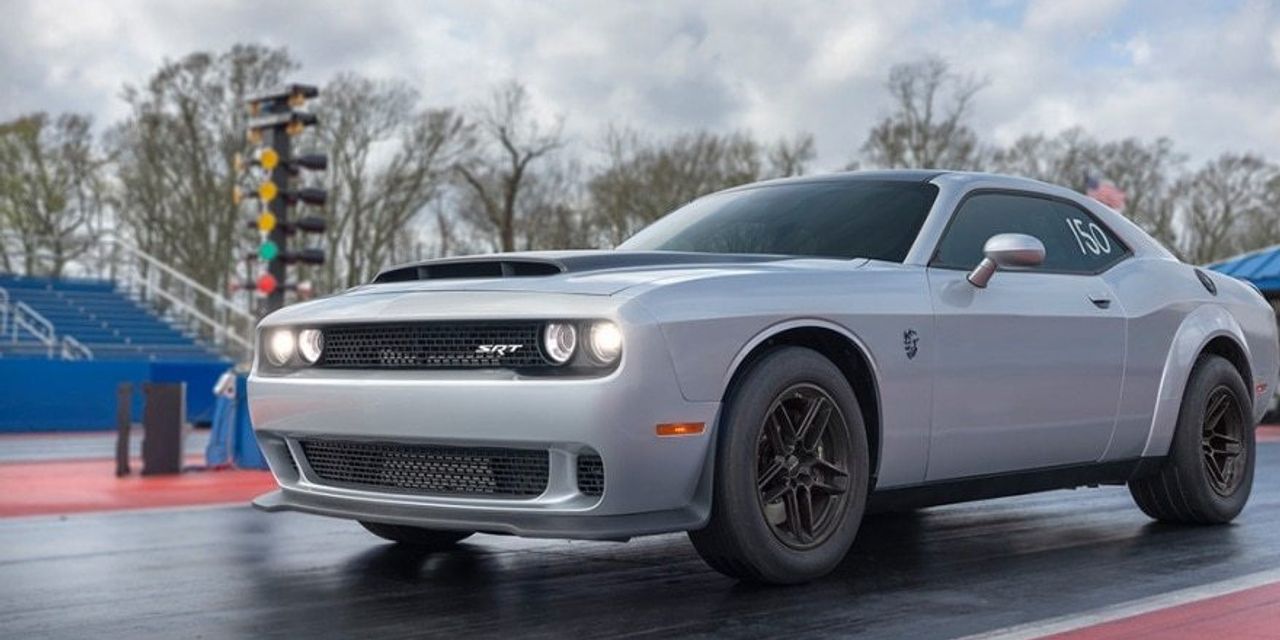The muscle car died exactly as it wanted.
In a blast of tire smoke and squeal, on a race track, burning gasoline so fast it could empty an 18.5-gallon tank in under five minutes.
In its final crowning moment, it set a record quarter-mile time for an absurdly cheap cost, measured in dollars per horsepower. Its point made; it can finally rest.
The week we said goodbye
Sometimes the high point is the end and the heart reels as it marvels.
The week of March 20, 2023, was emotional for America’s car lovers.
First came the high. Dodge unveiled its masterwork. The final Challenger. More on that in a moment.
Just two days later came the end. Another legendary muscle car builder made a goodbye announcement. Chevrolet retired the Camaro name — again. Not forever, they tell us. General Motors
GM,
plans to bring the classic name back on something someday. That may be a mistake. More on that in a moment, too.
But, for now, the Camaro will follow the Challenger into the sunset. And you’ll hear them long after they’re out of sight, as it should be with big, unbridled V8s burbling.
See: GM to stop making Camaros in January 2024
What all that buildup was for
Dodge is the only company that could do what it did. The company that calls its buyers “the brotherhood of muscle” has always seemed a little behind the times (in 2023, we all know “brotherhood” draws an unnecessarily tight circle). But its old-school spirit means it can tell purer stories than any other automaker.
The company announced months ago that its big V8, rear-wheel-drive (RWD) cars, the Charger and Challenger, would end their production runs this year. We knew the end was near.
We didn’t know a group of Dodge engineers had met in a parking lot in the early days of the COVID-19 pandemic and dedicated their spare time to ending it right. They agreed to build one final Challenger to beat them all. This week, they let us see it.
The 2023 Dodge Challenger SRT Demon 170 is absurd. Like every true muscle car, it looks brutal, not beautiful. It has the boxy lines a good muscle car should — defying the dictates of aerodynamics with raw power. It even looks unfinished, like someone’s perpetually in-process project car.
Engineers stripped off the front fender flares to save weight but left the rear ones. It looks like this thing left in the middle of something to outrun you.
With 1,025 horsepower (when filled with E85), it can outrun everything. Dodge says the Demon 170 can post a 1.66-second 0-60 time. It completes a quarter-mile in 8.91 seconds — so quick it breaks a National Hot Rod Association Rule against running that fast without a roll cage and parachute.
Most importantly, it finishes that quarter-mile run faster than a $2.9 million Bugatti Chiron SS. With a manufacturer’s suggested retail price of $96,666, it does it for about 3% of the Chiron’s price. That’s 94 bucks per horsepower.
Read: This is America’s most popular muscle car
Born in thousands of back yards and garages
Wikipedia traces the birth of the muscle car to the 1949 Oldsmobile Rocket 88 – the first time an automaker stuffed a V8 meant for a luxury car under a small coupe’s hood and sent it to the strip.
That’s as good a starting date as any, we suppose. But it’s dishonest to claim that the muscle car was born once.
A muscle car is an idea. Lots of people can have the same idea.
The Dodge Charger in the San Francisco chase scene in “Bullitt,” 1968.
Everett Collection
The term emerged in the 1950s, came into its own in the 1960s, and took over the automotive world in the 1970s. It’s hard to define precisely. Merriam-Webster says it’s “any of a group of American-made 2-door sports coupes with powerful engines designed for high-performance driving.” That’s probably as close as anyone will get. But the muscle car spirit is undefinable.
You knew it when you saw it.
It meant brutish cars less beautiful than curvy sports cars. They were typically all about the engine. Designers couldn’t care less about how the chassis could dance. Many had suspensions about as sophisticated as a Radio Flyer. They pushed the boundaries of what was possible for power in the carburetor age.
Serious power, playful mood
This makes them sound serious. They weren’t. Muscle cars were the most playful kind of car. They wore names inspired by predators or even cartoons. Mercury Cougar. Plymouth Barracuda. Plymouth Road Runner.
They were proudly silly. The 1969 Dodge Charger Daytona wore a cartoonishly high spoiler taller than its roofline. The Dodge Charger Super Bee wore a cartoon bee in a racing helmet a foot wide on its hood. These were not cars for people that didn’t know how to laugh at themselves.
The 1969 Dodge Charger Daytona
Sicnag/Wikipedia
But they were loud. They were RWD. They were more affordable than any of the European sports cars they threatened. And they were found in tens of thousands of garages, under thousands of shade trees, being worked on by self-trained mechanics who knew they could tweak the throttle body one more time and achieve glory.
Meant for a specific moment (or two)
Everyone knows how their glory days ended. The oil crisis of the 1970s made heavy cars with 8-cylinder engines and superchargers poking through their hoods unsustainable.
Some of the masters of the form — Dodge, Plymouth — got out of the game for years. Others faltered. There were no more AMC Rebel “Machines” when there was no more AMC.
A few continued in name only. No one would consider the curvy 2002 Camaro a muscle car. Those Fox-body Ford Mustangs lost the thread.
The muscle car, though, had a late-career resurgence. Like George Foreman winning all three heavyweight titles at 45, the muscle car hit harder than anyone expected long after its first retirement.
Starting with the 2005 Ford Mustang, boxy and overpowered cars came back. The Challenger was reborn in 2008. The Camaro in 2010. All three carried the extra weight most of us pick up in our later years — crumple zones and airbags have saved millions of lives but made it impossible to ape the classics exactly.
The Chevy Camaro
Chevrolet
All three fueled a rebirth of interest in the muscle car. But all three also felt like tributes. And they carried higher price tags, perhaps because the Baby Boomers that made the originals great had 401(k)s they could tap to fund a dream purchase now.
Fire makes way for lightning
What is bringing an end to that second surge? Its doom is cast of the same stuff as its glory.
We know this part is still slightly controversial, so we’ll keep it short and listen to the authorities.
The United States Environmental Protection Agency explains:
“Greenhouse gas (GHG) emissions from transportation account for about 27 percent of total U.S. greenhouse gas emissions, making it the largest contributor of U.S. GHG emissions. Between 1990 and 2020, GHG emissions in the transportation sector increased more in absolute terms than any other sector.”
If America wants to keep driving, it can’t do it on gasoline alone. Gasoline is glorious. But gasoline is destructive. If you doubt it, look to the severe weather of 2023 or the frighteningly more severe weather predicted for 2028.
So the auto industry is in the midst of the most important technology pivot since the start of the industrial revolution. It’s trading in gasoline for electricity.
Engineers who did their best work with fire are learning to work with lighting instead.
You can’t tune EVs under a shade tree
The pivot is vital. Even as car lovers, we know it’s overdue.
And we’ll gain track-day speed from the shift to electricity.
Internal combustion engines are like dimmer switches. Electric motors are like light switches. Internal combustion engines build up torque, or twisting force, in a curve like dimmer switches light up a room gradually, even if you turn them fast. Electric motors make 100% of their torque available at all times. Instantly. Like flipping a switch to activate a floodlight.
Energy is absent; then, it’s all there in a fraction of a second.
If you haven’t had the experience of flooring it in an electric vehicle, it’s hard to explain the visceral surge of it. It feels unreal. It’s not just that it’s quick. It’s that it’s casually quick. EVs that have no business feeling Ferrari-like can feel Ferrari-like. The Kia EV6 GT has a 0-60 time only Lamborghini and the like could manage a generation ago.
Only it’s not a Lamborghini. It’s a Kia.
That Challenger SRT Demon 170 is insanely quick. But it’s visibly (and audibly) making an immense effort to be insanely quick. That’s where the fun is.
It won’t be long before you can match it in a grocery-getter that even doesn’t grunt to do it.
The electric future is very good for people who love speed.
But something will be lost even as we gain a better future. You can’t tune an EV in your front yard with your grandfather’s wrenches.
More: Dodge’s electric muscle car emerges, and it will still rumble
The beauty of analog cars
There’s a term starting to bubble up in the automotive world that explains what we’re getting at here. Muscle cars are “analog cars.” They can’t be made digital without feeling like simulations.
The best of them can be fixed and maintained with tools you can get at a hardware store. They’ll never receive an over-the-air update. Nothing about them is so — coded.
That’s the best part of their glory. As America’s cars become more and more devices like our phones and tablets, the romance of a car that doesn’t connect to the internet will only grow.
Car lovers will always collect, tune, restore, and love them.
But no one will build new ones anymore.
Also on MarketWatch: Men over 50: clean up your act with these style and grooming tips
Simulations aren’t the same
The 1968 Ford Mustang GT 390 car used for the film “Bullitt,” starring Steve McQueen.
AFP/Getty Images
And some, let’s be frank, will build something they’ll call muscle cars. Something far from analog.
We’ve barely mentioned the Ford Mustang yet in this epitaph. And we need to talk about the Ford Mustang.
Having made their point, Dodge will retire the Challenger. We’re told the last one will roll off the assembly line in December. Chevy will soon reveal a special goodbye edition of the Camaro and retire that name, too. The factory will move on to something else next January, just weeks later.
But Ford
F,
has a seventh-generation Mustang planned. It will show up next model year — after everyone else has left the party.
We want to love it. It’s a Mustang, after all. (And yes, purists, a Mustang is a pony car. But a pony car is a type of muscle car. We don’t make the rules. Your heart does, and your heart wouldn’t ban a 1964-1/2 Mustang from a muscle car meet. It belongs).
But something about the seventh-generation Mustang feels wrong.
Maybe it’s the drift stick, an artificial parking brake of sorts that is digitally connected to the transmission and uses programming code to help you get sideways as if you were drifting manually. Maybe it’s the fact that you can buy an electric Mustang Mach-E. That’s a wonderful electric midsize SUV. But it’s not a muscle car.
Whatever the reason, something about the next Mustang feels a little like a simulation.
Dodge may go even further. The company is now touring an “electric muscle car” called the Charger Daytona Concept around the auto show circuit. It has classic muscle car styling and even makes fake engine noise. Dodge says it may preview a future product.
But it’s a simulation, too. Even its muscle-car-blocky nose is fake. It’s an optical illusion designed to look boxy but hide a more aerodynamic nose beneath so it doesn’t lose range to wind resistance.
And Chevy promises, “this is not the end of the Camaro’s story.” A Camaro EV is likely coming.
You might like: The all-new 2023 Dodge Hornet delivers the most powerful muscle among small SUVs
Let the next evolution come
The Pontiac GTO (1964-1967)
Alexander Migl/Wikipedia
Maybe those cars feel wrong because they are wrong.
We don’t know what the 2030’s descendent of the muscle car is. As cars become increasingly digital, with talk of subscription fees for heated seats and dial-a-horsepower programming, it’s harder to imagine the spiritual successor of the Pontiac GTO Judge.
And maybe it should be.
Muscle cars, as magnificent as they are, may be best as a treasured relic of an earlier time.
There will always be people buying cheap cars and making them faster. That tradition is older than the muscle car. They weren’t always called “muscle cars” because that name refers to something more specific.
We’d probably date the tradition of shade-tree wrenching to the World War II generation. Then, mechanics trained on early army trucks came home and started taking apart old Ford Model A cars, looking for a way to lighten them up and gain speed. They called them “hot rods.”
Muscle cars came later. They had the same spirit. But no one called them hot rods. They understood that a 1930s Lincoln with its V12 exposed and a 1967 Pontiac Firebird deserved different names.
In 20 years, when someone with a tablet reprograms a future Tesla
TSLA,
aiming for a 7-second quarter-mile, that will deserve its own name, too.
Muscle cars? Those will be classics, not something anyone is still building.
There’s no need to dilute what we got this week. We hope the Camaro and Challenger names get hung in the rafters. We hope the Mustang name gets retired before it gets embarrassing.
The muscle car era ended in March of 2023. A Dodge with a demon emblem with a neck tattoo (not making that up – it says “170”) beat a Bugatti in a quarter-mile and snarled into the sunset.
And that was the end of something beautiful.
This story originally ran on Autotrader.com.
Read the full article here










